How to Light a Fire in a Wood-stove Without Getting Burned
There are many different ways to light a fire in a wood-stove. Is there a “right” way? I’ll show you the method that works to keep you from getting burned. I like the top-down fire. It protects your knuckles from getting singed in the cook-stove when the paper flares up.
We’re experts at starting a fire, in fact, it’s done almost every day of the year. In our log home, we have both a Regency Close Clearance Wood Stove for heating and a Pioneer Maid Wood Cook-stove for cooking and heating. Our house is a two-story log house and the single wood heater wasn’t adequate to heat the whole house in very cold winter.
Since we’ve installed the Pioneer Maid Wood Cook-stove we only occasionally need to light the Regency stove. The cook-stove keeps the living area of our home at just the right temperature and the wood heater downstairs is lit once a day, in cold months, just to take the chill off the downstairs of our home and keep the bedrooms more comfortable.
Building the top-down fire in your wood-stove
Here are the basics for a top-down fire, which is the kind you’d use for a wood cook-stove. You want to have at least 4 logs in the firebox. Two logs on the bottom with the cut side up and another two logs laid on top of those, at right angles, with the cut side up. The logs should be touching each other.
- Start with seasoned, dry wood
- Split your firewood. Using round wood with the bark on takes longer to catch. It’s great to use once the fire is going but you don’t want to start your fire with it.
- Make sure the damper is open on the back of the chimney and the stove is set on full airflow
- You’ll leave the damper open until the fire is roaring — at least 15 minutes.
- Then close the damper, and adjust the airflow to keep the fire burning at the temperature that you want. Don’t close down the airflow before the bottom logs have caught fire.
Although you can burn green wood if you have to, it’s 100% better to plan ahead so that you have seasoned, dry wood to get you through the winter. Learn about the importance of dry wood and how to keep your firewood dry from previous articles in this series.
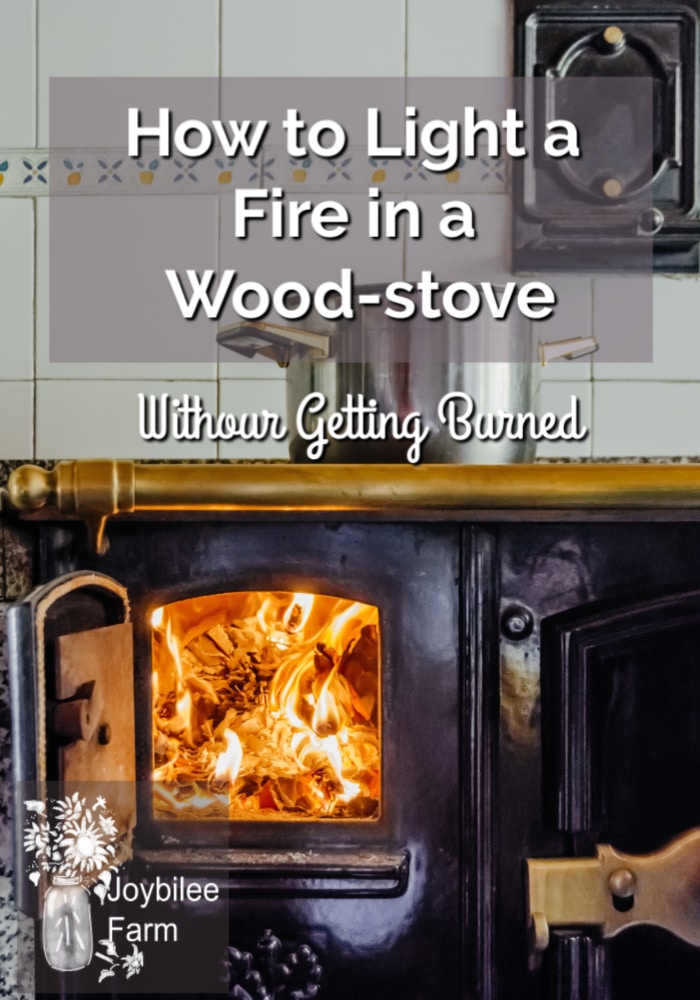
Follow the Boy Scout Motto for Fire Building:
One log won’t burn.
Two logs might burn.
Three logs will burn.
Four logs make a good fire.
Use quick-start dry kindling, like cedar or pine in your wood-stove
You will want kindling in 3 different sizes from 2 inches wide to 1 inch wide. Start with about a dozen pieces of the 1-inch wide kindling and a few 2-inch wide kindling pieces and then some larger pieces laid on top of the logs. The larger pieces will burn for a while to catch the bigger logs.
Lay the kindling on top of the logs. Place bigger pieces on the bottom, then the 2-inch pieces laid at right angles to those, and then the smallest kindling at right angles to those.
Crumble a wad of three or four pieces of paper to get the cedar going
Use any kind of paper you have handy. I often use 3 or 4 pieces of newspaper or the waste envelopes from junk mail. Even strips of cardboard boxes, just make sure whatever you choose is dry.
You can add a fire starter on top of the newspaper if you want. I’ve included directions to make DIY fire starters below.
Sometimes, on a particularly humid day, when we are having difficulty getting the draw just right through the stove, I will put a scoop of tallow on top of the kindling to get the whole thing burning, and put the paper on top of that.
Note: Although you use paper or cardboard to get the fire going, you don’t want to use your wood stove as a garbage burner. The resulting prolonged high heat will damage the inside of your firebox and your flue.
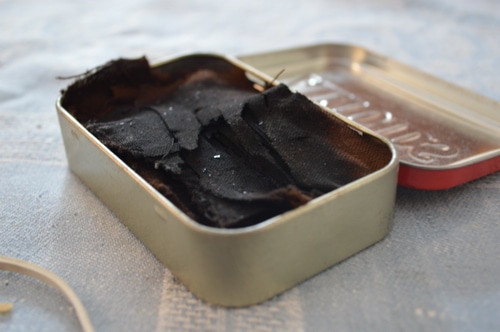
3 Easy DIY Fire Starters for your wood-stove:
Char Cloth is one of the best fire starters and easy to make. It is a slow-burning cloth that’s been carbonized to give it a very low burn temperature. Char cloth holds a flame for a long time, unlike a match or a flint, which is short-lived. Once you’ve caught a spark on a piece of char cloth you can feed it with tinder to get a cooking or heating fire going, even when it’s cold and damp outside.
Use pine cones and wax to keep them burning. If you live in the woods as we do, pine cones are readily available and make great fire starters. I’ll melt and pour beeswax, leftover candles, crayons, or even beef tallow over the cones in a muffin tin, lined with a cupcake liner and let them dry. We keep them in a basket near the fire. Add ground cinnamon or nutmeg (optional) for a sweet scent while they burn.
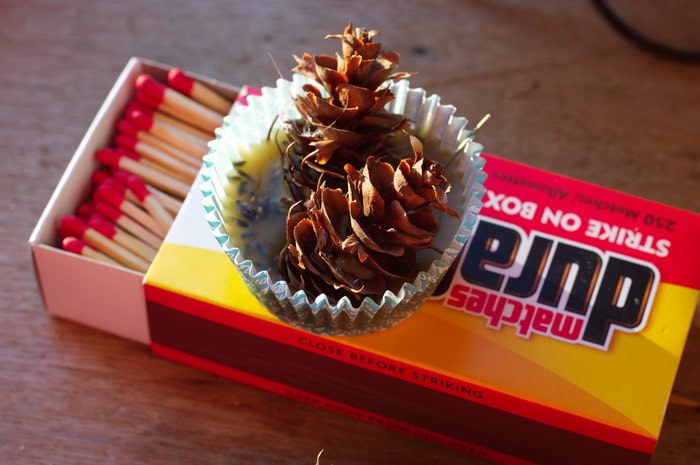
Using larger pine cones for fire starters
- Gather pine or fur cones and let them dry indoors for a week or two.
- Melt leftover candles, crayons, beeswax or tallow in a can in a pot of water. The pot might get coated in wax so use a pot reserved for this purpose, not your best cookware.
- Line a baking sheet with parchment paper.
- Tie a string of seine twine around each pine cone in the middle.
- Dip the pine cone into the wax. Allow it to harden on the parchment paper and redip at least 4 times. Leave a one-inch piece of string for a wick. You can scent the wax by adding some powdered cinnamon or nutmeg to the wax if you like. These make nice Christmas gifts, too.
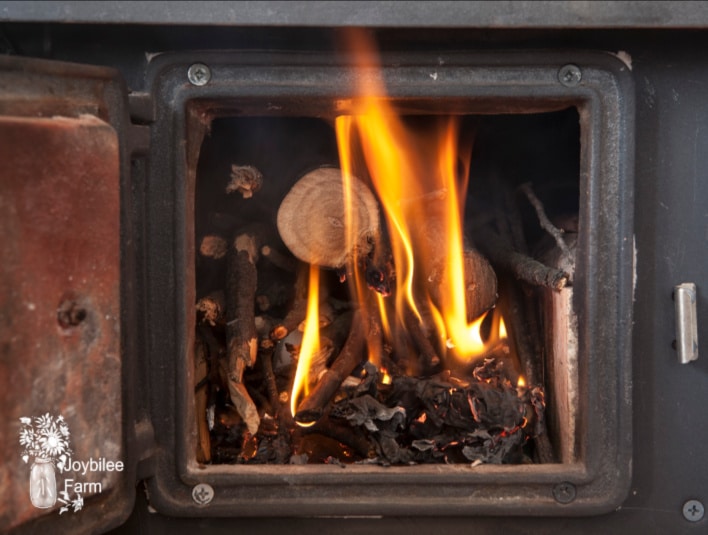
Observing a few cautions around wood-stove fires
You’ll get years of safe enjoyment out of your wood heaters and your wood cook-stove if you follow these rules.
First, fires burn and clothing can catch fire.
- Don’t wear flowing clothing around an open flame. Especially watch those flannel nightgowns with the flowing sleeves, when you are adding wood to the fire.
- Don’t let children add wood to the stove unsupervised, they aren’t as cautious as adults.
Second, watch long hair when you are adding wood to a wood cook-stove.
- Flowing hair can catch fire. The smell is terrible, I know from experience.
- Keep your hair tied back if you’ll be leaning over the wood-stove with the firebox cover open.
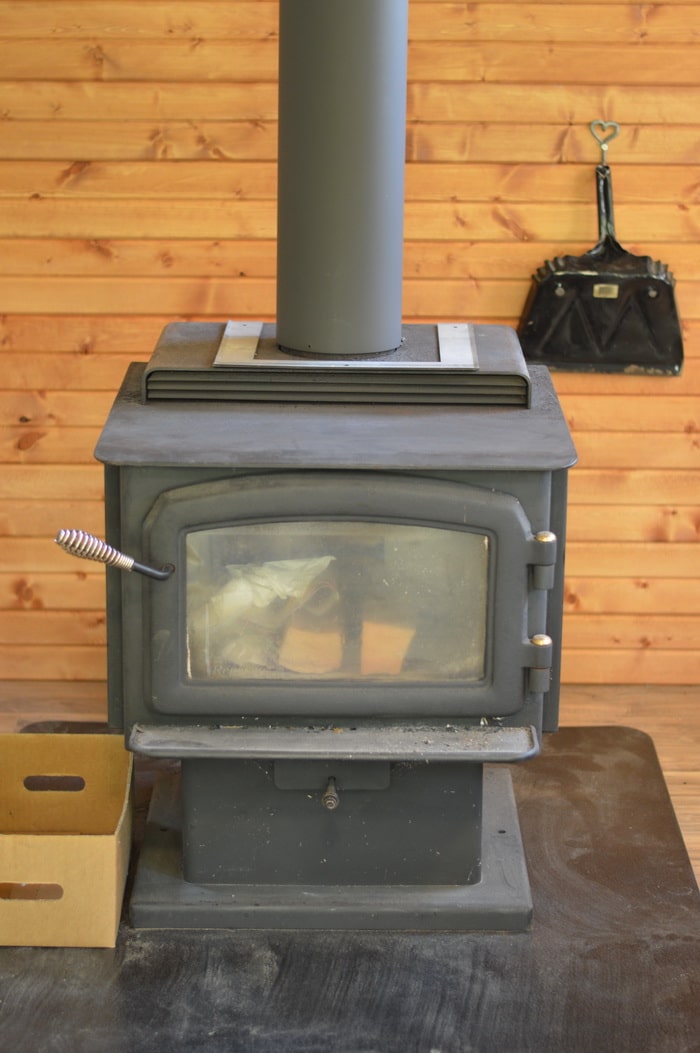
Cleaning out the ashes of your wood-stove
When you empty the ash-pit from your stove put the coals and ashes directly into a metal can and leave it open and exposed to air to extinguish any flame. You want to give it time to cool completely. Only after they are cold, should you put ashes into a metal garbage can with a lid for storage. Never put wood ashes into a wooden or plastic compost bin. They can flame up, unexpectedly, even after you think they are cold.
Yes, I’ve done this. Learn from my mistake.
Wood-stove ashes make good garden amendments, can be used for dust baths for your backyard chickens, or used as an alkalinity adjunct for natural dyeing.
Never, ever, vacuum the ashes out of your wood stove. Ashes can look dead due to being smothered. But dead ashes could fan to a flame when they are infused with oxygen inside your vacuum cleaner with cataclysmic results. We’ve done this, twice. It ruined the vacuum cleaner. But if we’d had a built-in vacuum it would have burned our house down. Scary. Learn from my mistakes.
Your turn:
What’s your favourite way to light a fire in a wood-stove? Do you have any secrets that will help our readers keep the home fires burning? Leave a comment.

BTU of 25 firewood species chart
Explore the BTU ratings of 25 different firewood species with this downloadable chart and get my best tips for Firewood storage and safety by clicking the pink Free download button below.
Other Articles in the Wood Stove Series:


